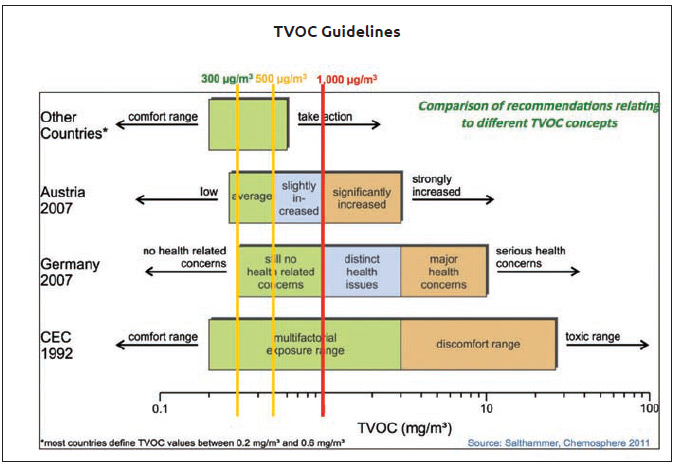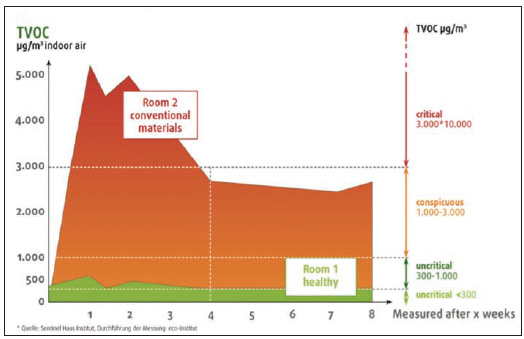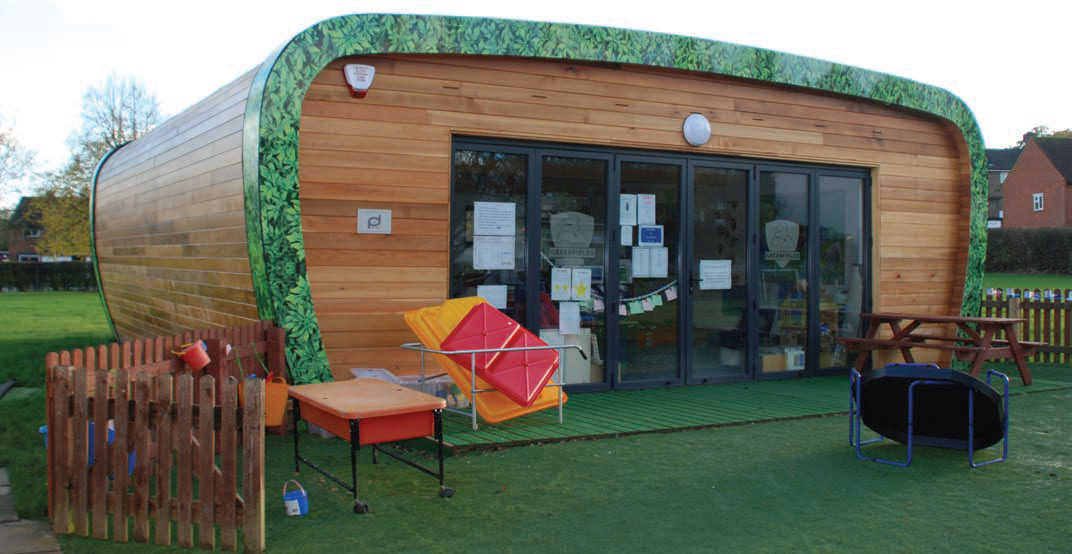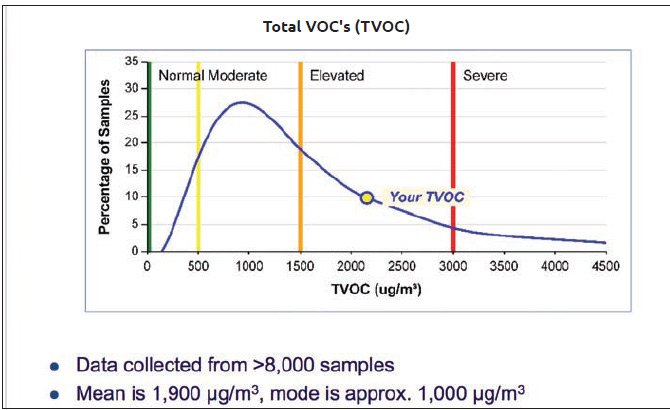VOCs, a Volatile Issue
28 March 2018What does reducing VOCs mean for the panels industry? Simon Corbey of the Alliance for Sustainable Building Products and Ceri Loxton of the BioComposites Centre, Bangor University combine their expertise to explain an issue that will grow in importance.
The wood based panels industry is no stranger to changing regulations. The significant reductions in the emissions of formaldehyde from panel products over past decades is testament to this. Over the past 30 years, emissions of formaldehyde from wood based panels have fallen from approximately 3 ppm to 0.1 ppm – a very significant change. If levels continue to fall they may be lower than those from natural wood.
Today the focus has widened. Attention now is on VOCs or Volatile Organic Compounds, of which formaldehyde is just one.
VOCs are emitted by a wide variety of sources – natural wood and wood based panels are among them – and can accumulate inside rooms in higher concentrations than are found outdoors. Increasing concerns have been raised over their impact on the quality of the air that we breathe inside buildings, and on the impact this may have on human health.
A number of reports, from bodies as various as the Royal College of Physicians, parliamentary groups, and the European Commission Directorate-General for Health and Consumers, have highlighted the issue. Some companies have started to look at how the ‘health’ of a building can influence the productivity of their workforce.
Politicians are starting to take note. It is an issue which is bound to grow in importance, and which in the near future the panel industry is almost certain to have to address. It will not, though, be easy. A number of factors contribute to this. At present VOCs are little understood. Their composition, their emission rates, how these change over time, and their effects – all these need further study before meaningful regulations can be drawn up.
It is very difficult to associate particular VOCs, or products that emit them, directly with particular health complaints. Nevertheless evidence is growing, and for some chemicals – formaldehyde is an example – the effects are known to a certain extent.
Nor are VOCs a single compound. Instead the term covers a huge number of organic compounds which can be released into the atmosphere of a house or workplace in quantities and proportions that vary from case to case and over time. They are numerous, varied and ubiquitous. Indeed they are frequently deliberately introduced into both home and work environments in the form of air fresheners, scented cleaning products and the like.
Approximately a thousand chemicals evaporate into the air that we breathe in our homes and workplaces and fall collectively under the umbrella of VOCs.
At present there is little monitoring of indoor air quality. Yet humans spend the majority of their lives, approximately 90% of it on average, indoors. The quality of air inside buildings can therefore impact considerably on health.
Factors such as dampness, or the presence of moulds and fungi, are obviously relevant here; so too is the chemical composition of the indoor air that we breath. In urban areas levels of VOCs indoors are often two to five times higher than outdoors.
In rural areas this state of affairs can be reversed. Wood in its natural state while alive and growing emits VOCs; the air in woodlands and forests can have higher concentrations than many indoor environments.
Sources of VOCs within indoor environments are many and various. Wood indoors, either in solid form as timber beams and studs or as engineered products in panels, flooring or furniture, emits VOCs.
But so too do products containing no wood at all: paints and varnishes, adhesives, mastics, cements, carpets and vinyl flooring and insulation products are all buildingrelated materials that emit them. Products such as air fresheners, cleaning cosmetics, upholstery and foams are other sources of indoor VOCs; activities such as smoking, cooking, and burning fuels also contribute.
Health Effects
The health effects of long-term exposure to low levels of VOCs are poorly researched, and the cumulative effects of emissions from all the different sources are even less well understood. That said, health effects from VOCs are generally divided into two categories, acute and chronic, depending on dose and level of exposure. Acute effects include irritation of eyes and respiratory tract; general headaches; dizziness; lack of co-ordination; nausea; visual disorders; and allergic reactions such as asthma and rhinitis.
Chronic effects have been listed as damage to liver, kidneys, circulatory systems and central nervous system, and links to cancer.
Among the general public, awareness bears the popular name of ‘Sick Building Syndrome’. It is widely perceived that certain people feel ill in certain buildings. Symptoms include fatigue, headaches, breathing difficulties, strained eyes and itchy skin.
Individuals within a population will have different tolerances, so effects will vary, which makes quantification of health effects even harder to measure. It is acknowledged, however, that children, the elderly, and those already in poor health are most at risk from poor air quality. A 2014 investigation by Franklin and others found a significant risk of infants suffering from respiratory diseases in the first year of life. The authors of that report linked the observed health risks to increased concentrations of VOCs breathed in by expectant mothers from new laminate flooring.
We said above that to date there has been little monitoring of indoor air quality. This will change. The wood panels industry is familiar with testing techniques for emissions of single products. A selected product is placed in a test chamber of standard size and concentrations in the air of the emission of interest - say formaldehyde – are measured.
However, measuring of VOCs in an internal built environment is more complex and the results are much less specific. Identifying which particular material is responsible for an unusually high reading can sometimes be difficult.
All the available measurement methods for VOCs are selective in what they can measure and in what they can accurately quantify. None are capable of measuring all the VOCs that are present. Some measure what is described as ‘TVOC concentrations’ – the total concentration of multiple airborne VOCs present simultaneously in the air.
Yet despite the name they do not in fact measure all the VOCs, but only a subset of them. Each method measures its own particular subset of VOCs – and the subsets can vary considerably. Thus different TVOC measurements can yield substantially different TVOC concentrations, depending on what VOCs are included in its subset.
A further difficulty is that individual VOCs may have very different toxicities and effects. Thus lumping them all together into a total measurement is not likely to produce a useful measure of toxicity. That said, the TVOC methods are cheap, and can provide guidance on the overall levels of indoor pollution.
Furthermore, consumers, particularly members of the public who are experiencing allergic symptoms, are increasingly requesting analysis of indoor air quality and are starting to test their own home environments. ‘Home test kits’ are available at modest prices for the purpose. One such is from Waverton Analytics, priced at £140. It consists of a tube and pump which the user plugs in for a set period of time and then returns to the lab for the air thus sampled to be analysed.
Currently, however, most post-occupation studies of buildings use CO2 as a proxy for air quality. A guideline of 1,000ppm of CO2 is recommended. The drawbacks of carbon dioxide as a proxy are obvious. One is that CO2 sources bear little relation to sources of VOCs.
Guidance on Air Quality
In March 2017 the Local Government Association in the UK published guidelines on outdoor air pollution. Its 116 pages condensed findings and information for the use of health specialists. No comparable briefing exists for indoor air quality. It will be interesting to see how long it will be before such a document emerges.
Any guidance on air quality and VOCs is likely to continue to change over time as more data becomes available. Additionally, the links between certain chemical groups and specific health outcomes may become better understood. The effects of short and long-term, and lifetime, exposures, and cumulative responses and interactions with other chemicals, will come to light. It is a complicated area and one requiring much more work and attention.
Policy
There is no dedicated European legislation on indoor air quality. In the UK, no single government body is responsible. The Public Health Outcomes Framework (2016 – 2019) makes local authorities responsible for improving air quality; the UK Buildings regulations Part ADF specify that total VOC emissions should be below 300μg/m3 over eight hours measured post completion but before occupation.
However it has been suggested by the European Protection Agency that these limits are without toxological justification, and that domestic exposure at lower levels may increase childhood asthma. So it seems highly likely that these figures may change as understanding increases.
The Department for Education’s revised Buildings Bulletin BB101 Guidelines on ‘ventilation, thermal comfort and air quality in schools’ was due to be published in May/ June 2017, but at time of writing has not been. It will supersede the 2006 version, which did not have the term ‘air quality’ in the title. The addition reflects the increasing importance that authorities are now giving to indoor air quality in schools.
Case Study
A case study here may be relevant. In 2016 a concerned head teacher in the UK, reacting to high levels of pupil and staff discomfort, requested an indoor air quality test for a recently-built classroom.
Formaldehyde levels were found to be 950 ppm, ten times World Health Organisation guidelines, some twelve months after occupation. A repeated test by another provider gave similar results.
The classroom provider admitted in a personal communication with the author that he knew very little about specifying for low formaldehyde. No further comment on the case is currently possible, but it does highlight that developers do not have a good understanding of the effects that product selection can have on air quality.
Sentinel Haus, a German organisation which carries out testing of buildings for quality of internal air, has reported on a research project involving two small children’s classrooms constructed in a laboratory. The first used conventional materials, the second used only Sentinel Haus approved products. In the conventional classroom TVOC levels of 5,000μg/m3 were measured in week 1, reducing to 2,800μg/m3 in week 4, and eventually to 2,700 μg/m3 at week 8. The German Environment Protection Agency suggests that anything over 1,000μg/m3 is not recommended for long term exposure. In the approved-products classroom, TVOC levels never rose above 500μg/m3 – see Fig1.
When furniture was introduced, TVOC levels rose, in the conventional room to 8,100μg/ m3. This makes a good argument for pre-off gassed furniture.
Conclusions
For these and other reasons, VOCs are a subject that the panels Industry will have to take seriously.
Issues around indoor air quality and VOCs are increasingly going to come under scrutiny. As the evidence base linking air quality, health and wellbeing, productivity and performance grows, standards and regulations are likely to tighten.
Improvements in methods to measure VOCs in the home and workplace, and falling costs and increasing ease with which these tests can be carried out, will mean that post-occupancy performance issues can be monitored and inevitably linked, rightly or wrongly, to impacts on health.
Communication will be important to maintain public confidence in the safety of wood based products.
The panels industry along with the wider wood industries and trades need to work with other industries and associations in the built environment supply chain to help simplify the language about indoor air quality to make the issue more understandable by non-experts and to communicate the risks in ways that the public can understand.
The rise in interest will mean that clients living with panels and contractors installing them will increasingly be demanding full declaration of contents for the products and systems involved.
Specifiers will increasingly be demanding low VOC products and more monitoring of indoor air quality will be conducted. The industry will need to collaborate across the supply chain to ensure the delivery of buildings that are healthy, that are seen to be healthy, and that can be acknowledged and certified as such.



